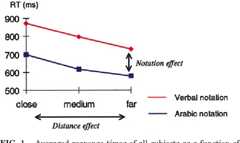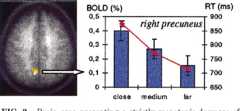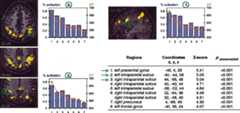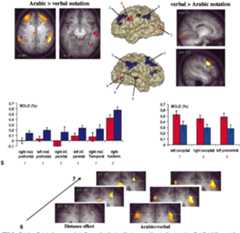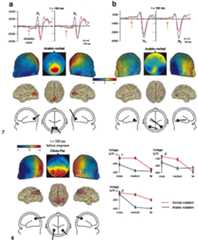DOI:10.1006/nimg.2001.0913 - Corpus ID: 17633857
Modulation of Parietal Activation by Semantic Distance in a Number Comparison Task
@article{Pinel2001ModulationOP, title={Modulation of Parietal Activation by Semantic Distance in a Number Comparison Task}, author={Philippe Pinel and Stanislas Dehaene and Denis Rivi{\`e}re and Denis LeBihan}, journal={NeuroImage}, year={2001}, volume={14}, pages={1013-1026}, url={https://api.semanticscholar.org/CorpusID:17633857}}- P. PinelS. DehaeneD. LeBihan
- Published inNeuroImage1 November 2001
- Psychology
The time to compare two numbers shows additive effects of number notation and of semantic distance, suggesting that the comparison task can be decomposed into distinct stages of identification and…
702 Citations
Topics
Number Comparison Task (opens in a new tab)Behavioral Distance Effect (opens in a new tab)Triple-code Model (opens in a new tab)Semantic Distance (opens in a new tab)Semantic Processing (opens in a new tab)Activations (opens in a new tab)Event-Related fMRI (opens in a new tab)Precuneus (opens in a new tab)Posterior Cingulate (opens in a new tab)
702 Citations
The Semantic System Supports the Processing of Mathematical Principles
- Jie LiuLi YuanChuansheng ChenJiaxin CuiHanqi ZhangXinlin Zhou
- 2019
Mathematics, Psychology
The neural origin of the priming distance effect: Distance‐dependent recovery of parietal activation using symbolic magnitudes
- Karolien NotebaertM. PesentiB. Reynvoet
- 2010
Biology
It is shown that bilateral parietal activations present a distance‐dependent recovery of activation positively correlated with the distance between primes and targets, and that the relative importance of the semantic and nonsemantic pathways in a dual‐route model of number processing is modulated by symbolic notation.
Number representation in the parietal lobes
- S. Göbel
- 2002
Psychology
The first experiment demonstrates that repetitive Transcranial Magnetic Stimulation (rTMS) can be used on normal subjects to replicate findings from studies of patients whose ability to calculate after brain injury was impaired and suggests that parietal cortical contribution to number magnitude representation is intimately related to its role in basic sensorimotor processes.
Distinct neural mechanisms for reading Arabic vs. verbal numbers: An ERP study
- A. ProverbioMarco BiancoFrancesco De Benedetto
- 2018
Psychology
The data suggest distinct mechanisms for number reading through ciphers (digits) or words, and it can be speculated that numerosity processing would involve circuits originally involved in processing space (i.e., rAG/rIPS).
THREE PARIETAL CIRCUITS FOR NUMBER PROCESSING
- S. DehaeneM. PiazzaP. PinelL. Cohen
- 2003
Biology
The horizontal segment of the intraparietal sulcus appears as a plausible candidate for domain specificity: It is systematically activated whenever numbers are manipulated, independently of number notation, and with increasing activation as the task puts greater emphasis on quantity processing.
Mapping numerical perception and operations in relation to functional and anatomical landmarks of human parietal cortex
- Elisa CastaldiA. VignaudE. Eger
- 2019
Biology
The results reveal a functional heterogeneity within human intraparietal cortex where the visual field map representations in superior/medial parts ofIPS and superior parietal gyrus are involved predominantly in numerosity perception, whereas numerical operations predominantly recruit lateral/inferior parts of IPS.
Automatized clustering and functional geometry of human parietofrontal networks for language, space, and number
- O. SimonFerath KherifS. Dehaene
- 2004
Computer Science, Psychology
Neural correlates of the numerical distance effect in children
It is proposed that the left IPS would be engaged in the refinement of cognitive processes involved in number comparison during development, while the right IPS would underlie the semantic representation of numbers and its activation would be mainly affected by the numerical proximity between them.
...
59 References
Functional anatomy of a common semantic system for words and pictures
This study studied the functional anatomy of semantic processing by using positron-emission tomography to contrast activity during two semantic tasks (probing knowledge of associations between concepts, and knowledge of the visual attributes of these concepts), performed either with words or with pictures.
Neuroanatomical Substrates of Arabic Number Processing, Numerical Comparison, and Simple Addition: A PET Study
- M. PesentiM. ThiouxX. SeronA. Volder
- 2000
Psychology
Comparison and simple addition fact retrieval revealed a fronto-parietal network involving mainly the left intraparietal sulcus, the superior parietal lobule and the precentral gyrus, whereas addition also activated the orbito-frontal areas and the anterior insula in the right hemisphere.
Event-related fMRI analysis of the cerebral circuit for number comparison.
The results confirm the role of the right fusiform gyrus in digit identification processes, and of the inferior parietal lobule in the internal manipulation of numerical quantities, in the serial-stage model of the number comparison task.
Distinct Cortical Areas for Names of Numbers and Body Parts Independent of Language and Input Modality
- G. L. Clec'HS. DehaeneD. Bihan
- 2000
Psychology, Biology
These results complement the existing neuropsychological and brain-imaging literature by suggesting that within the extensive network of bilateral parietal regions active during both number and body-part processing, a subset shows category-specific responses independent of the language and modality of presentation.
Graded Functional Activation in the Visuospatial System with the Amount of Task Demand
The data suggest that the amount of activation in the various cortical regions that support visuospatial processing is related to the amount, as well as to the type, of computational demand.
The visual word form area: spatial and temporal characterization of an initial stage of reading in normal subjects and posterior split-brain patients.
- L. CohenS. DehaeneF. Michèl
- 2000
Psychology, Biology
Brain : a journal of neurology
The findings provide direct support for the main components of the classical model of reading and help specify their timing and cerebral substrates.
The Organization of Brain Activations in Number Comparison: Event-Related Potentials and the Additive-Factors Method
- S. Dehaene
- 1996
Psychology
How the simultaneous recording of event-related potentials (ERPs) in the same task can provide complementary information that cannot be obtained using RTs alone is described.
Dissociating Prefrontal and Parietal Cortex Activation during Arithmetic Processing
Functional magnetic resonance imaging findings indicate a dissociation in prefrontal and parietal cortex function during arithmetic processing and provide the first evidence for a specific role for the angular gyrus in arithmetic computation independent of other processing demands.
Collaborative Activity between Parietal and Dorso-Lateral Prefrontal Cortex in Dynamic Spatial Working Memory Revealed by fMRI
- V. DiwadkarP. CarpenterM. Just
- 2000
Biology
The comodulation of activation in the prefrontal and parietal areas by the amount of computational demand suggests that the collaboration between areas is a basic feature underlying much of the functionality of spatial working memory.
...
Related Papers
Showing 1 through 3 of 0 Related Papers
